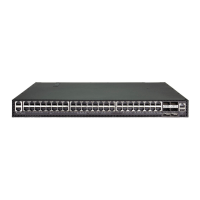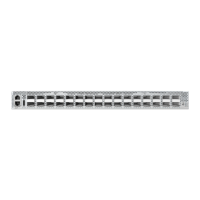Chapter 19
| VLAN Commands
Configuring L2CP Tunneling
– 486 –
l2protocol-tunnel
tunnel-dmac
This command configures the destination address for Layer 2 Protocol Tunneling
(L2PT). Use the no form to restore the default setting.
Syntax
l2protocol-tunnel tunnel-dmac mac-address
mac-address – The switch rewrites the destination MAC address in all
upstream L2PT protocol packets (i.e, STP BPDUs) to this value, and forwards
them on to uplink ports. The MAC address must be specified in the format
xx-xx-xx-xx-xx-xx or xxxxxxxxxxxx.
Default Setting
01-12-CF-.00-00-02, proprietary tunnel address
Command Mode
Global Configuration
Command Usage
◆ When L2PT is not used, protocol packets (such as STP) are flooded to 802.1Q
access ports on the same edge switch, but filtered from 802.1Q tunnel ports.
This creates disconnected protocol domains in the customer’s network.
◆ L2PT can be used to pass various types of protocol packets belonging to the
same customer transparently across a service provider’s network. In this way,
normally segregated network segments can be configured to function inside a
common protocol domain.
◆ L2PT encapsulates protocol packets entering ingress ports on the service
provider’s edge switch, replacing the destination MAC address with a
proprietary MAC address (for example, the spanning tree protocol uses 10-12-
CF-00-00-02), a reserved address for other specified protocol types (as defined
in IEEE 802.1ad – Provider Bridges), or a user-defined address. All intermediate
switches carrying this traffic across the service provider’s network treat these
encapsulated packets in the same way as normal data, forwarding them across
to the tunnel’s egress port. The egress port decapsulates these packets, restores
the proper protocol and MAC address information, and then floods them onto
the same VLANs at the customer’s remote site (via all of the appropriate tunnel
ports and access ports
10
connected to the same metro VLAN).
◆ The way in which L2PT processes packets is based on the following criteria – (1)
packet is received on a QinQ uplink port, (2) packet is received on a QinQ access
port, or (3) received packet is Cisco-compatible L2PT (i.e., as indicated by a
proprietary MAC address).
10. Access ports in this context are 802.1Q trunk ports.

